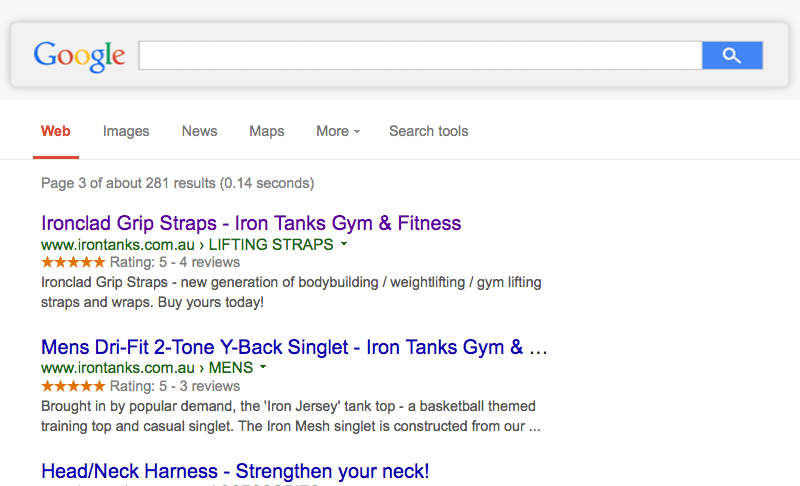Celine lives in San Francisco. Today, she’s interested in getting a pair of socks as a birthday gift for her colleague at work. Unfortunately, there’s no store close by where Celine can walk in to purchase the socks.
Since she needs the socks badly, she decides to make a search online for a physical store nearby or better, an online store where she can place an order and get the socks delivered to her on the same day.
The quick search presents Celine with some results. As she scans through the results, she’s confronted with the dilemma of which page to visit first.
At this stage, a number of factors will help Celine decide which of the pages to visit first. And when she does decide which page to visit, how that product page is laid out, will determine whether she buys the socks on the page or whether she comes back to the search results page to check out more pages.
For many, if not all of us, our buying experience is the same as that of Celine. We resort to search engines when we want to buy a product, learn more about the product or to identify places where we can buy the product from.
When presented with the search results, one of the crucial things that gets us convinced on which page to visit out of the many results or whether to actually make the purchase are product reviews.
In this post, I’ll be covering how product reviews affects a potential buyer’s decision making and how to make the most out of them.
Let’s get to it.
Value of product reviews
A study by the Institute of Cognitive Neuroscience at University College London on how online reviews influence the perception of a product showed that opinions about a product are very much influenced by reviews.
The study involved 18 participants who were to rate a range of Amazon products based only on the image and product description. The participants were then asked to score the products a second time, but this time, were shown the image along with aggregated user reviews, which displayed the average score and total number of reviews.
The results showed the second round of ratings were between their original score and the average, a clear indication of how the reviews swayed their opinions.
In Science Daily’s commentary on the study, it noted, “When making judgements that were influenced by user reviews, the researchers saw that two adjacent brain areas that are used in social cognition, and to represent value, were most active. The way the participants updated their ratings was in line with a mathematical model of Bayesian integration, which has previously been demonstrated to capture many aspects of human perception.”
Dr Benedetto De Martino, the study’s lead author, talking about the study said “Humans are innately social, so it makes sense that we are swayed by the opinions of the group. While there’s value in sticking to your own beliefs, it can also be beneficial to take other people’s opinions into account, and not over-value your own opinions,”
From the study, it is clear reviews significantly influence how potential buyers perceive value or are able to assess a product.
Rich Snippets and High Click Through Rates (CTR)
As mentioned earlier, when presented with search results, one of the crucial things that helps us decide which of the pages to visit first is product reviews. In the search results, the product reviews come up as additional information. This additional information is referred to as rich snippets.
Rich snippets are additional pieces of information that search engines are able to identify on a page and used to enhance the searcher’s understanding of the value of that page. Ratings, pricing, and availability are commonly seen in ecommerce rich snippets.
The image below shows rich snippets in action.

The first two listings in the image stand out and draw attention. They do because they carry more relevant information. The relevant information in this case is the display of the product ratings.
The display of additional information makes a potential buyer more likely to check out the page instead of the others on display in search results. Having the rich snippets increases a site’s CTR and an increase in CTR is a very good thing for a business. In fact, some case studies showed a 30% increase in CTR after implementing rich snippets.
The rich snippet didn’t just show up. It was pulled from the reviews on the product page. This means ratings rich snippets will not show for product pages that do not have reviews or product pages that have reviews but are not consciously informing the search engines to show them.
For product pages that do not have product reviews, the business owner should make the effort to collect reviews for the products on sale. There are product reviews software (apps) out there that can help in the collection of reviews.
To get search engines to show rich snippets for a page, add schema markup (microdata) to your product page’s HTML using Schema.org. Here also, there are product reviews software that can inject schema markup to enable rich snippets to show for product pages.
Product reviews and increased conversion rate
Social proof is a strong force when it comes to making purchase decisions. The higher the number of good product ratings on a product page, the better the conversion rates of that product page. According to statistics by Reevo, 50 or more reviews per product page can mean a 4.6% increase in conversion rates. Also, site visitors who interact with both reviews and customer questions and answers are 105% more likely to purchase than visitors who don’t interact with reviews and customer questions (Bazaarvoice, Conversation Index, Q2 2011).
Showing reviews from past customers is a great way to make a strong case for a product as being worthy of purchase, Whilst on a product page, potential buyers have a lot of questions on their mind. Some of the questions being;
“Is this product affordable”
“Am I getting value for money”
“Is this product going to be as I see it”
“Do I trust this business to ship the product to me after making a purchase” and so on.
By having product reviews on the page, the reviews from past customers will be answering all these questions the visitor to your site has. For a question like, “am I getting value for money”, the reviews displayed show the visitor that indeed this product has been purchased and used by others and they are happy with it.
In short, by showing what other happy customers think about the products, a potential buyer is comfortable also making the decision to buy the product.
Managing negative product reviews
We all dislike negative reviews. But negative reviews are negative reviews and shouldn’t be allowed to affect emotions or businesses. Many reasons account for why a customer may leave a negative review.
1– The customer is just not the right fit for your business. Your product(s) may not serve the needs of a customer and this could be a reason for a negative review. Remember, if a business is going to be best for some customers, then it’s not going to satisfy some customers since people have different tastes.
2– Something was done wrongly. People make mistakes and so do businesses. If a bad review was made due to a mistake by the business, then there’s less to worry about, the bad review should be taken as a form of feedback. Correcting those issues is going to ensure future customers are delighted about their shopping experience.
3– The customer may just be having a bad day. There are good days and there are bad days. Occasionally, a customer may write a review on a bad day and this may reflect in the content of the review. Since you cannot control people’s bad days, such negative reviews shouldn’t be allowed to affect your emotions.
From the above, you realise that as a business, you should have no fear of negative reviews. Another reason that this fear is unnecessary is the fact that negative reviews can actually have a positive effect on the business.
Having negative reviews in a mixture of positive reviews, will make the positive reviews believable. A Harvard Business School study found out that majority of potential customers trust reviews more when they see a mixture of bad and good reviews.
So negative reviews are not all that bad but you should learn to manage them well.
In one of our blog posts, The 4 Kinds of Reviews and How to Make Use of Them, we outlined the following as what is to be done in managing negative reviews.
“The first thing you should do is to comment on the review so the customer realises that even if your product/service sucks, well you don’t suck.
Next, look into the issue and find a solution. Was it a delayed delivery? Check what caused the delay and make it up to the customer. Wrong or damaged product? Ship a new one immediately. I recommend if your product is not highly priced, you bear the cost of this. Why? The positive words that come from a previously dissatisfied customer is worth a million.
Everyone knows bad things happen every now and then so proving that you know how to handle them builds even more trust in your business. Whatever you do, never ever ignore a negative review, even if you are not at fault. In the world of business, the customer is always right. Render an apology anyway and get the customer smiling again. You should publish the negative review along with the comment. Boasting about your success in handling negativity is such a positive thing. ”
Consider using product reviews software, as some are helpful in managing negative reviews. The software will quickly escalate any negative review to draw your attention and provide an easy way to follow up with the reviewer.
Using product reviews outside the product page
We have talked about the psychological value of product reviews in convincing potential customers to click on your page from the search results and in convincing visitors on your product page to make a purchase.
There are other uses of product reviews aside using them on your website.
Product reviews can be used in marketing such as email marketing and will bring its psychological value to bear just as when used on a website.
1– Product reviews can be used to collect more reviews. Humans are social beings and so will behave or think just as the popular behaviour or thought. When soliciting reviews from new customers, you can attach reviews from past customers and these new customers will be willing to write a review because they have seen reviews from others.
And if the reviews you attached are positive, the new reviews will also very likely be positive.
2– Sell products with reviews. If there’s a discount sale, don’t only send emails with the discount or run ads about the discount. Consider using reviews in the message. The reviews will make potential customers comfortable enough to take advantage of the discount.
3– Use reviews to answer customer questions. If a potential customer asks a question about a product, adding reviews that seem to answer the question in your response is a great way to make your response more believable. If you made a mistake with an issue, say in delivery, adding reviews from past customers will reassure the customer that what happened was a one-off and will not recur.
Conclusion
We have seen how product reviews play a psychological role in getting potential customers or visitors to your site to perform an action that will be in the interest of your business goals. Whether it’s getting your site clicked on out of many other sites or convincing a visitor to make a purchase of that product being stared at or it’s using old reviews to attract new reviews, product reviews are important considerations for any online business. There are product reviews software and apps out there that can help in the proper collection and management of product reviews and if the right investment is made with them, an online business can significantly grow its business. Take the learnings from this post and apply them to see progress.









